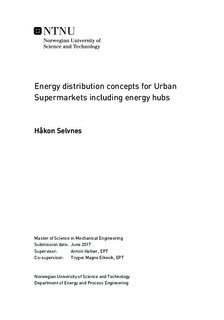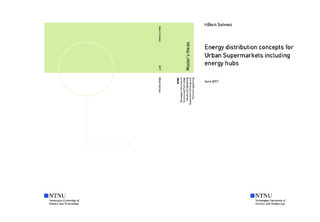| dc.description.abstract | More and more of the earths population is living in urban areas. This indicates that
using urban building plots for combined purposes will be important in the future. For this
reason supermarket chains are developing new building concepts that includes supermarket
sales area, apartments on the upper floors and parking lots with energy supply hubs for
the new generation of hydrogen/electric vehicles. This master thesis emphasizes this concept
by designing the complete energy system for such a building and taking into account
demands for heating, cooling and refrigeration. A literature review of subsystems and
components relevant for the different parts of the building concept was performed. This
includes supermarket refrigeration systems, hydrogen refueling stations, energy systems
for high performance buildings and thermal storage. Based on the findings from the literature
study, a complete design for the building energy system was proposed. The purpose
of the energy system is to integrate the different subsystems together to enable heat recovery to use for space heating and domestic hot water, and thereby minimizing the import of primary energy to the building plot.
A key feature of the energy system is that it is organized in three circuits with different
temperature levels. They include a high temperature water circuit for domestic hot water, a
medium temperature water circuit for space heating and low temperature antifreeze circuit
connected to boreholes for heat storage, cooling of ventilation air and as a heat source.
Space heating in the building is covered by a low temperature 28/33°C return/supply floor
heating system as well as heating of ventilation air. Hour-by-hour energy demand over a
year for space heating and domestic hot water for the building was obtained by developing
a model of the building envelope in the software SIMIEN. The data obtained was based on
assuming a plausible layout and design for this type of building. The supermarket occupies
the whole first floor of the building and thirty apartments the three next floors, separated
into ten apartments on each floor. The building envelope is designed according to the requirements and specifications to the Norwegian passive house standard. Four weeks were
picked from the yearly demand report from SIMIEN to give as input to the simulation
of the energy system. The four weeks serves as boundary conditions for a performance
investigation of the energy system during spring, summer, fall and winter.
To evaluate the chosen design of the energy system three different variants of the system,
called case 1, 2 and 3, was developed in the dynamic simulation software Dymola.
The three models were simulated for all four weeks and the results compared. Case 1 involves
integrating the supermarket refrigeration system to the centralized heating system
in the building and delivering waste heat from the gas coolers to space heating and domestic
hot water. Simulations show that by operating the system in trans-critical mode, heat
recovery could cover the full demand of domestic hot water in the building for all weeks.
In addition, the full space heating demand could be covered by heat recovery for the summer
and spring week, and reaching a share of 75.4% and 31.4% for the fall and winter week. Remaining heat demand in the building was covered by a R290 ground source heat pump connected to the energy wells on the evaporator side.
Case 2 and 3 investigate heat recovery from the hydrogen refueling station in two different
ways in addition to heat recovery from the supermarket refrigeration system. The
waste heat at the hydrogen station is due to the operation of an electrolyser, compression
of hydrogen gas and precooling of hydrogen gas during filling of vehicles. The available
waste heat/refrigeration load in case 2 and 3 was linked to the daily production level of
hydrogen gas in the electrolyser. The production was assumed constant through the day,
and equal for all days of the week, giving a constant waste heat availability. In case 2,
an antifreeze cooling circuit from the hydrogen station brings waste heat at 45°C to the
centralized heating system of the building, and the heat is recovered to space heating by a
heat exchanger. In case 3, the hydrogen station is integrated entirely with the CO2 booster
refrigeration system in the supermarket, and the refrigeration demand at the station is covered by it. The first comparison between case 1, 2 and 3 was based on a daily production
of 50 kg of hydrogen fuel, corresponding to 25% of maximum installed capacity. Results
showed that case 2 and 3 displayed similar performance for space heating heat recovery,
where both could satisfy the space heating demand for summer, spring and fall week, and
about 60% during a winter week. Due to high uncertainty in the demand for hydrogen
fuel in the area, a parameter study of the hydrogen production level was carried out. The
production level was varied from 10% to 100% and simulated for the winter week. For
both case 2 and 3, a daily production level of 75% (150 kg) and higher could cover all
space heating demand. In addition, case 3 showed a large potential to supply domestic hot
water, up to 5.5 times the demand of the building at maximum daily production of 200 kg
hydrogen. Case 1 is considered the minimum integration that should be carried out for the
building concept, as large energy savings can be achieved with small modifications to a
standard CO2 booster system. If the hydrogen station is to be integrated, the case 3 design
is the better option. It can deliver similar performance to space heating as case 2, but can
in addition deliver a large supply of domestic hot water. If case 3 design of the system is
chosen, delivering domestic hot water to neighbouring buildings should be considered to
use the full potential of waste heat that is available. | |

